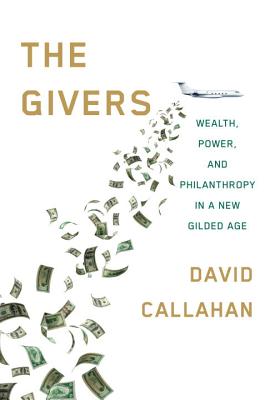Periodically we hear about wealthy multi-millionaires and billionaires establishing foundations in order to give away substantial chunks of their wealth during their lifetime, or after they pass on. Callahan points out that there is nothing new about this, and he ticks off donors from previous generations, such as Andrew Carnegie, Henry Ford and the Rockefeller Family. The difference in today’s giving is that the number of super-wealthy Americans is far larger than the census of robber barons and capitalists of the late 19th and early 20th century. For example, he points out that in 2015 there were five thousand households that had assets of over one hundred million dollars. Even equity investment groups like Fidelity or Charles Schwab have joined the fray, helping the super-rich to identify cases that are appropriate for these philanthropists to give money to.
[alert variation=”alert-info”]Publisher: Knopf
Formats: Hardcover, eBook, Kindle, Audible
Purchase: Powell’s | Amazon | IndieBound | iBooks[/alert]
Another difference in today’s philanthropy that the author discusses is that many of today’s philanthropists are younger capitalists who cashed out of internet start-ups. The author discusses in considerable depth the positive and negative results of today’s philanthropy. Since the money is generated by the enthusiasm of a particular donor, there are few controls over where the money goes. Conservative philanthropists like the Koch Brothers use their money to advance conservative causes, while such benefactors as George Soros or Samuel Gill support the liberal causes that they deem worthwhile. Another controversial matter that the author examines is that often the money is distributed without any input from the particular community that will be affected by this influx of cash. He describes how the Gates Foundation plowed two billion dollars into breaking up large high schools into smaller units, but later abandoned the strategy. Since foundations don’t really have to answer to the general public, such experiments can be conducted without any sort of penalty.
The operations of large foundations are complex and involves large groups of employees. As an example, Callahan cites the mammoth Gates Foundation, with its 1,400 employees in Seattle. Discussing other examples of such largesse, the author asks if “we think it’s okay for any philanthropists to have so much power to advance their own visions of a better society.”
For those who are interested in availing themselves of foundation money, Callahan explains that America has over 90,000 private foundations, with over $700 billion in assets, and the “vast majority” of them don’t give any grant-seekers a way to get in touch with them. Another example of foundation near-sightedness that Callahan cites is the eagerness of donors to wipe out major diseases with dramatic financial contributions, while ignoring the health problems of the poor who are not receiving efficient or effective medical care. The final irony explained by the author is that some of the philanthropists already discussed continue to make so much money that they will literally be unable to give away all of their money, not only during their lifetimes, but in several generations to come.
Overall this is a fascinating and a fair-minded book. Some readers may become overwhelmed with the number of donors discussed, and their various techniques for disposing of their money. I think that most readers will find these details essential, and even quite interesting. If only the audience for the book reaches present and future philanthropists, we may find ourselves living in a better world.
[signoff predefined=”Social Media Reminder” icon=”twitter”][/signoff]

